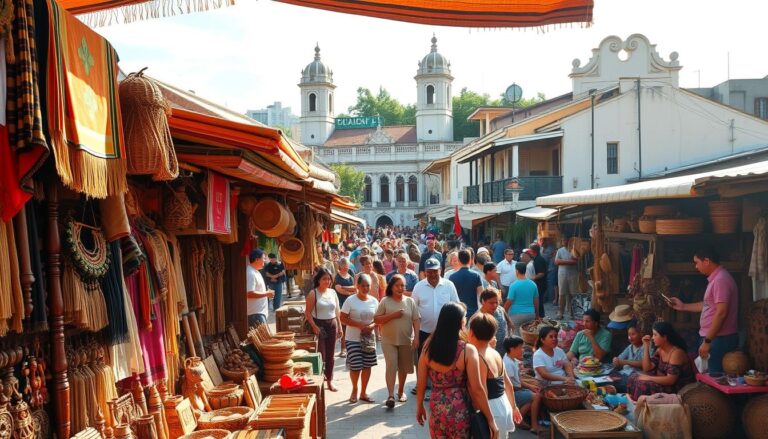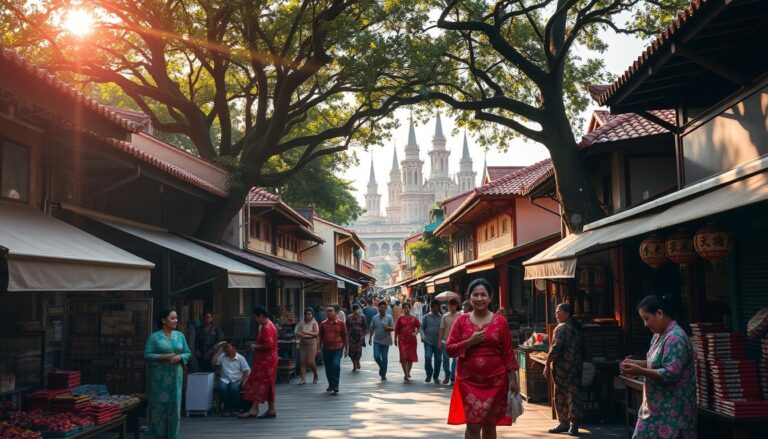Japanese Occupation of the Philippines: A Dark Chapter
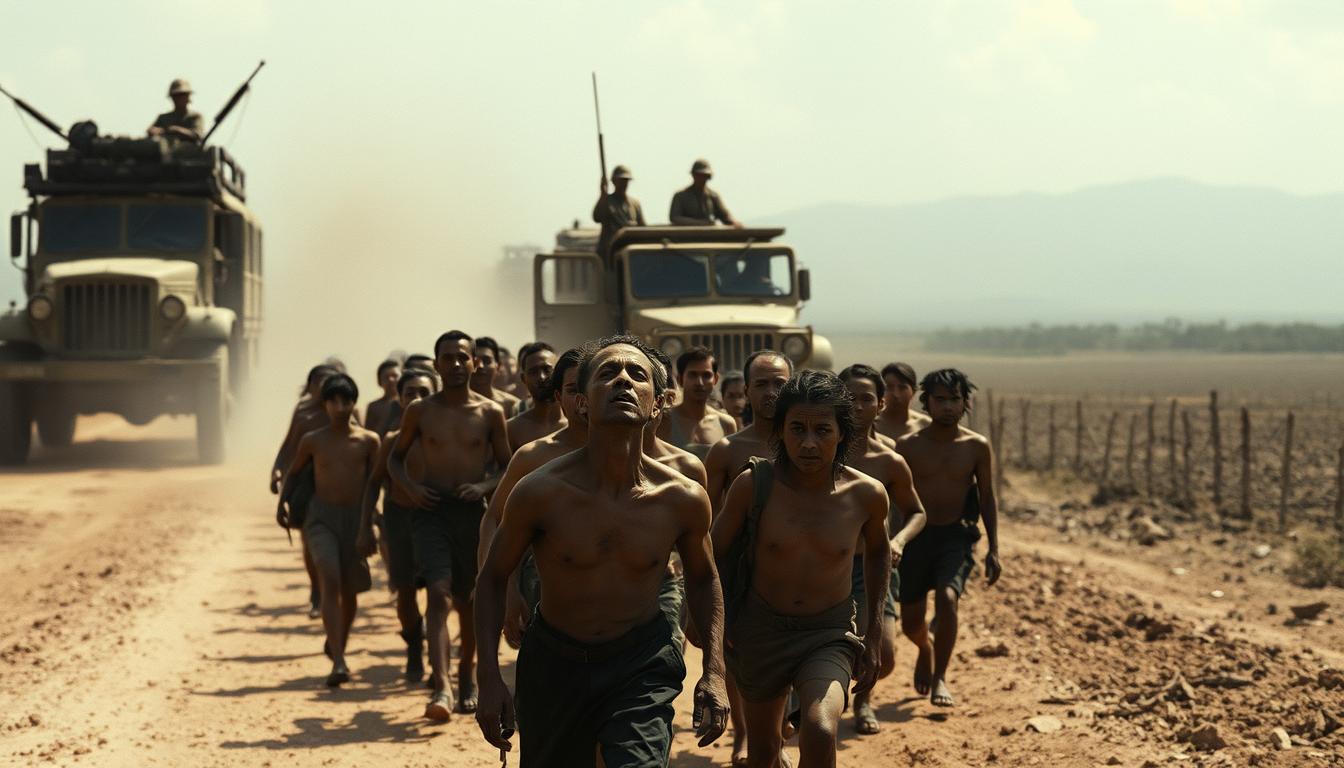
World War II brought immense suffering to Southeast Asia, with one of its most tragic episodes unfolding between 1942 and 1945. During this time, foreign forces seized control of the archipelago, marking a brutal period of coercion and violence. The invasion began just hours after the attack on Pearl Harbor, triggering a swift military campaign that overwhelmed local defenses.
Among the darkest events was the Bataan Death March, where thousands of prisoners endured unimaginable hardships. Over 75,000 Filipino and American troops were forced to march without food or water, leading to thousands of deaths. This atrocity remains a stark symbol of wartime cruelty.
The United States, which had colonial ties to the region, played a critical role in the conflict. General Douglas MacArthur’s return in 1944 galvanized resistance efforts, paving the way for liberation. Local guerrilla groups also fought tirelessly, demonstrating remarkable courage amid widespread devastation.
Understanding this era is vital to honoring its victims and learning from history’s lessons. The scars left by mass suffering, political turmoil, and foreign intervention still resonate today. As we explore this complex period, we uncover stories of resilience that define a nation’s spirit.
Background of the Conflict
Decades of colonial rule and regional rivalries laid the groundwork for one of World War II’s most brutal periods. Southeast Asia’s strategic location and resources made it a target for imperial powers long before 1941.
Pre-War Regional Tensions and Colonial Legacy
By the 1930s, the archipelago operated as a U.S. commonwealth with limited autonomy. This arrangement left its defenses dependent on foreign forces—a vulnerability exploited during later invasions. Meanwhile, expanding empires competed for dominance across the Pacific, creating a powder keg of territorial disputes.
Historical Context Leading to Occupation
The Pearl Harbor attack on December 7, 1941, acted as a catalyst. Within hours, military campaigns targeted key Pacific territories. This coordinated assault aimed to cripple Allied capabilities and secure vital supply routes.
Regional instability worsened as colonial powers prioritized their interests over local needs. Resource shortages and political neglect fueled resentment among populations. These conditions allowed aggressive forces to advance rapidly through weakened defenses.
Escalating conflicts set the stage for catastrophic events like the Bataan Death March. Over 75,000 captured troops faced forced marches under brutal conditions—a direct consequence of strategic miscalculations and unpreparedness. Such tragedies underscore how historical grievances and power struggles shaped this dark era.
The Impact of Pearl Harbor
Within hours of the December 7, 1941 attack, strategic decisions set the stage for rapid conflict expansion across Southeast Asia. Airfields like Clark Field faced destruction on December 8, crippling Allied airpower. This coordinated strike aimed to disable defenses and secure resource routes simultaneously.
Linking Pearl Harbor and the Pacific War
The surprise assault created immediate chaos. Military planners abandoned War Plan Orange, shifting to beachhead defenses under urgent conditions. As one officer noted, “We lost critical hours debating retreat routes while enemy forces advanced.”

Consequences for the Philippines
Resource shortages plagued defenders as territorial gains accelerated. Guerrilla units like the Hunters ROTC emerged within months, harassing supply lines. Civilians endured forced labor while resistance networks gathered intelligence for Allied counterstrikes.
Urban centers fell quickly after Manila’s capture in January 1942. The three-month Battle of Bataan revealed how time-critical decisions affected survival rates. By April, over 70,000 troops faced brutal marches – a direct result of disrupted communication and overwhelmed command structures.
Invasion of the Philippines and Early Battles
December 1941 saw coordinated strikes reshape Southeast Asia’s landscape. Following Pearl Harbor, forces swiftly targeted key airfields like Clark and Iba, crippling Allied defenses. This paved the way for rapid territorial gains across the archipelago.
Strategic Japanese Advances
Invaders leveraged surprise and superior airpower to overwhelm unprepared garrisons. By January 1942, Manila fell without resistance as defenders retreated to Bataan. General Douglas MacArthur ordered a tactical withdrawal, buying time for Allied regrouping.
Japanese units encircled key positions, cutting supply lines. Their blitzkrieg-style tactics exploited fractured communication networks. Within weeks, critical ports and infrastructure fell under foreign control.
American and Filipino Resistance
Outgunned troops mounted fierce defenses at Bataan and Corregidor. Despite starvation and ammunition shortages, they delayed enemy progress for three months. A Filipino officer later recalled, “Every hill became a fortress—every retreat, a chance to regroup.”
Guerrilla networks emerged, disrupting supply routes and gathering intelligence. These efforts laid groundwork for future counteroffensives. The Pacific War’s early phase showcased both desperation and defiance against overwhelming odds.
Life Under Japanese Rule
Daily existence became a battle for survival under the new regime. Families faced empty markets and silent streets as foreign forces tightened their grip. Basic necessities vanished, replaced by ration cards and endless queues.
Daily Hardships and Social Disruption
Food shortages reached catastrophic levels, with rice prices soaring over 137,500%. Many survived on banana stalks and coconut sap as farms were seized to feed occupying troops. A survivor recalled, “Hunger clawed at us daily—even children forgot the taste of rice.”
The Kempeitai’s presence loomed large, using brutal methods like thumb-hanging to crush dissent. Curfews and checkpoints fractured communities, while informants turned neighbors into suspects. Forced labor programs drained villages of workers, crippling local economies.
Cultural foundations crumbled as schools closed and traditions faded. Underground newspapers became lifelines, spreading hope against strict censorship. These years of oppression left deep scars, reshaping family dynamics and national identity for generations.
By 1945, the archipelago’s GDP had plummeted 70%, exposing the occupation’s economic toll. Yet amid the rubble, small acts of defiance—like hidden radios broadcasting Allied news—kept resistance alive.
The Infamous Bataan Death March
The spring of 1942 witnessed one of WWII’s most harrowing human tragedies unfold on Philippine soil. After months of intense fighting, over 76,000 exhausted troops surrendered—a decision that triggered a 66-mile nightmare.
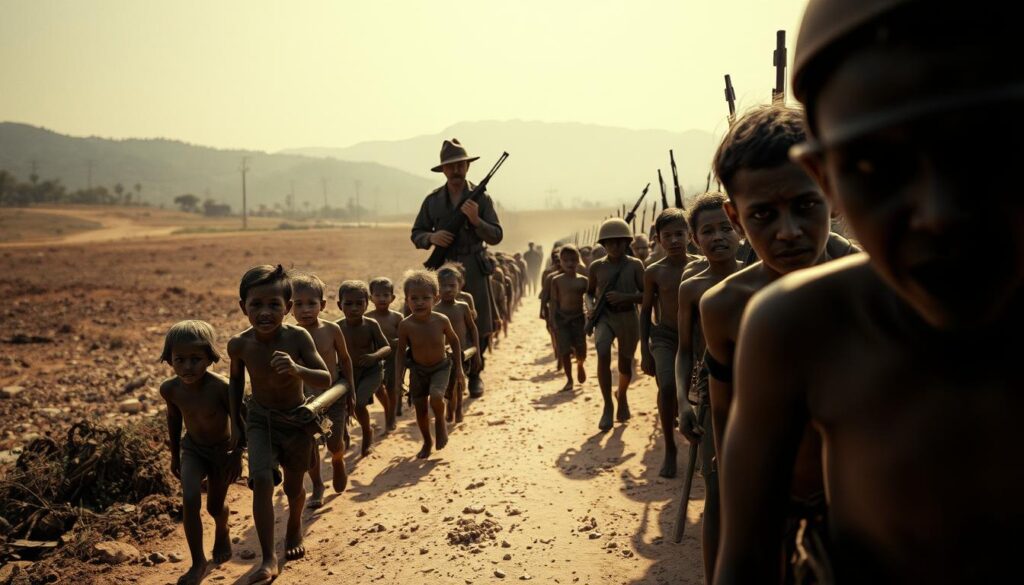
Causes and Consequences
Logistical failures and overcrowded POW camps forced captors to move prisoners inland. Starving soldiers faced tropical heat and deliberate cruelty during the trek. Survivor Bert Bank recalled, “Guards stabbed men who stumbled—the road became a graveyard.”
Approximately 650 Americans and 5,500 Filipinos perished from beatings or executions. Thousands more died later from disease in camps like O’Donnell. This systematic brutality exposed the invaders’ disregard for human life.
Testimonies and Lasting Legacy
Firsthand accounts reveal prisoners drinking muddy water and eating tree bark. One survivor described sun treatment torture: sitting exposed for hours without shade. These stories fueled Allied propaganda and global condemnation.
The march became a rallying cry for resistance fighters. Guerrilla networks intensified sabotage operations, using gathered intelligence to disrupt supply routes. Annual memorials now honor victims while educating new generations about wartime resilience.
War Crimes and Atrocities
Acts of unimaginable cruelty defined daily life under military rule. Over 100,000 civilians perished in Manila alone during 1945’s month-long slaughter. Schools and hospitals became killing fields, with survivors recalling soldiers ripping open pregnant women and using children as human shields.

Civilian Suffering and Brutality
The Bayview Hotel massacre epitomized systemic violence. Over 400 women endured weeks of repeated assaults in its halls before execution. “They burned our church with families inside,” testified a priest from Santo Domingo. Mass graves at Dy-Pac Lumberyard still hold victims of orchestrated extermination campaigns.
Human Experimentation and Unpunished Crimes
Medical units conducted deadly tests on prisoners, injecting pathogens to study biological warfare effects. Though General Tomoyuki Yamashita faced execution, most perpetrators escaped justice. A Supreme Court justice noted during appeals: “This trial sets dangerous precedent for victor’s vengeance over true accountability.”
General Douglas MacArthur’s administration prioritized geopolitical stability over thorough prosecutions. Only 300 war criminals faced trials—a fraction of those implicated. Survivors waited decades for memorials as governments avoided confrontations.
The task of documenting these horrors remains unfinished. While international tribunals later adopted stricter standards, many victims never saw their tormentors punished. General Douglas MacArthur’s complex legacy in this process continues sparking debate about how nations reckon with war’s darkest chapters.
Establishment of a Puppet Government
Political theater replaced democratic processes as foreign forces reshaped governance structures in 1943. The Philippine Executive Commission, formed months after the hours attack pearl Harbor, became a facade for military control. Its successor—the Second Republic—emerged under strict supervision, with policies designed to legitimize foreign dominance.
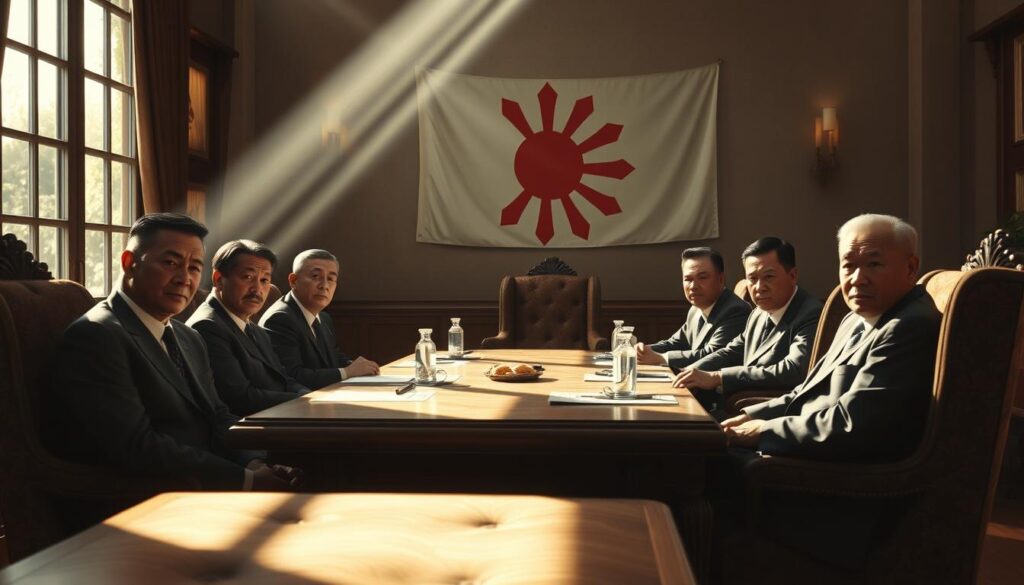
The Rise of President José P. Laurel
Selected for his legal expertise and pre-war nationalist views, Laurel faced impossible choices. Occupiers pressured him to lead while the U.S. Army regrouped overseas. “I serve not conquerors, but survival,” he reportedly told aides during the 1943 inauguration. His administration inherited empty coffers and food riots worsened by Japanese currency policies.
Collaboration and Political Manipulation
Elite families split between resistance and cooperation. Some joined the KALIBAPI party to protect assets, while others secretly funded guerrillas. The puppet regime declared war on America in 1944—a move opposed by 73% of legislators under duress.
Post-war investigations revealed how occupation forces manipulated local laws to seize resources. Though the U.S. Army later restored Commonwealth rule, distrust of political elites lingered for decades. Laurel’s controversial exoneration in 1948 highlighted the complex legacy of wartime alliances.
Guerilla Warfare and the Filipino Resistance
Hidden networks of defiance emerged as foreign forces tightened their grip. Farmers, students, and soldiers formed secret units across Luzon and Mindanao, using rugged terrain to their advantage. These groups became the backbone of a shadow war that drained enemy resources.

Organized Underground Movements
By mid-1942, over 300 guerrilla bands operated nationwide. The Hunters ROTC—composed of military cadets—staged daring raids, including the liberation of Los Baños prison camp. Sabotage missions targeted railways and supply depots, slowing troop movements across the archipelago.
Survivors of Bataan formed units like the Luzon Guerrilla Force. They adopted Maoist tactics, avoiding direct clashes while winning civilian support. One fighter noted, “We moved like ghosts—striking fast, vanishing faster.”
The Role of the Hukbalahap and Other Groups
Mount Arayat’s dense forests sheltered the Hukbalahap, a communist-led force that grew to 15,000 fighters. Their slogan—“Anti-Japanese Above All”—united peasants against rice seizures. Meanwhile, Moro warriors in Mindanao used terrain knowledge to push troops back to coastal bases.
These efforts crippled supply lines and provided critical intel for Allied forces. When U.S. troops returned in 1944, guerrillas guided them through enemy-held zones—a decisive factor in reclaiming the far east.
Role of General Douglas MacArthur
A commander’s defiant vow reshaped the Pacific War’s trajectory in 1942. After delaying enemy advances for months, General Douglas MacArthur received urgent orders to relocate to Australia. His departure from Corregidor in March left forces in the Philippines under overwhelming pressure but ignited a strategic vision for liberation.
The Promise to Return
Upon arriving in Melbourne, MacArthur declared: “I came through, and I shall return.” This pledge became a beacon of hope for resistance fighters. Guerrilla networks amplified his words through hidden radios, countering enemy propaganda across villages.
Leadership in the Face of Adversity
MacArthur’s tactical brilliance emerged during Allied counteroffensives. He prioritized retaking the archipelago over bypassing it—a decision that required convincing Roosevelt to divert resources. Despite criticism over delayed evacuations, his blueprint for island-hopping campaigns proved decisive.
The Japanese army fiercely defended key positions, prolonging battles like Leyte Gulf. Yet MacArthur’s October 1944 landing fulfilled his promise, strategically timed to maximize psychological impact. Troops wading ashore heard his broadcast: “People have waited—behind me comes a force to break the yoke.”
His leadership left enduring lessons in military strategy and nation-building. From overseeing postwar reconstruction to accepting the Philippines’ 1946 independence, MacArthur’s legacy remains etched in collective memory. The Congressional Gold Medal awarded decades later underscored his role in confronting war crimes and restoring sovereignty.
Allied Counteroffensives in the Philippines
October 1944 marked a seismic shift in the Pacific conflict as Allied troops launched their largest amphibious operation to date. Coordinated strikes aimed to break enemy control and reclaim strategic islands. This bold move combined naval power, air superiority, and guerrilla intelligence—a blueprint for modern warfare.
The Leyte Invasion and Reclaiming Territory
On October 20, the Sixth U.S. Army stormed Leyte’s eastern shores under General Douglas MacArthur’s command. Seventh Fleet ships provided cover while bombers neutralized coastal defenses. A veteran recalled, “We waded through chest-deep water, but every step felt like liberation.”
The Battle of Leyte Gulf shattered remaining naval strength in the region. Over 280 Allied vessels faced desperate kamikaze attacks—yet secured victory within four days. This cleared the path for ground forces to advance inland.
| Campaign | Key Strategy | Outcome |
|---|---|---|
| Leyte Landing | Amphibious assault with air support | Established critical foothold |
| Bataan Peninsula | Flanking maneuvers & guerrilla aid | Secured Manila Bay access |
| Luzon Advance | Combined ground-naval operations | Liberated capital by March 1945 |
Retaking the Bataan Peninsula proved vital for controlling supply routes. U.S. troops landed at Subic Bay in January 1945, supported by local fighters who sabotaged enemy lines. This pincer movement trapped Japanese forces in mountainous regions.
International cooperation accelerated success. Australian bombers disrupted reinforcements, while Filipino scouts identified weak points in defenses. By isolating key positions, General Douglas MacArthur’s forces minimized casualties while maximizing territorial gains.
These offensives crippled enemy logistics and morale. With airfields restored, Allied planes dominated skies—a decisive factor in ending the conflict. The campaign’s success reshaped postwar geopolitics across Asia.
Japanese Military Tactics and Strategies
Forces leveraged terrain advantages and psychological warfare to dominate contested regions. In Northern Luzon, commanders transformed mountains into fortified networks, avoiding direct beach confrontations. Swift aggression defined early campaigns, with air raids crippling supply lines before ground troops advanced.
Urban strongholds showcased adaptive strategies. Salvaged naval guns became hilltop sentries, while civilians were forced to build barriers. “Every building became a bunker,” noted a guerrilla fighter’s diary from Manila. This approach prolonged battles but intensified civilian casualties.
Defensive measures evolved as resistance grew. By 1943, over 3,500 rebel incidents forced tactical changes—propaganda campaigns replaced mass executions in some areas. Prisoners of war faced systematic brutality, reflecting a strategy to crush morale through fear.
Northern Luzon’s rugged landscape later hosted desperate last stands. Invading forces burned villages to root out sympathizers, accelerating local opposition. Such methods backfired, fueling intelligence networks that guided Allied counterattacks.
Treatment of captives mirrored broader strategic failures. Executions and forced labor alienated populations, turning neutral zones into resistance hubs. These tactics left lasting scars while failing to secure long-term control.
Social and Cultural Impacts of Occupation
Lourdes Montinola’s hands shook as she described losing her siblings: “They took our home, then our dignity—but never our will to remember.” Personal accounts like hers reveal how years of conflict reshaped communities far beyond battlefields.
Long-Lasting Trauma and Resilience
The invasion philippines shattered family structures. Over 500,000 deaths left villages filled with orphans and widows. Survivors faced nightmares for decades—a 1946 study found 68% exhibited PTSD symptoms. Yet resistance efforts birthed new leadership roles. Women managed underground networks, challenging traditional gender norms.
Cultural identity transformed under pressure. Schools taught foreign languages, but secret classes preserved local history. A former teacher recalled hiding textbooks: “We wrapped them in banana leaves—our knowledge couldn’t be buried.” Annual memorials now blend Catholic rituals with guerrilla hymns, honoring both loss and defiance.
| Aspect | Pre-War | Post-Occupation |
|---|---|---|
| Societal Roles | Male-dominated leadership | Women in resistance networks |
| Cultural Practices | Spanish-influenced traditions | Hybrid memorial rituals |
| National Identity | Colonial mindset | Pride in guerrilla legacy |
The attack pearl Harbor triggered events that still echo today. Veterans’ grandchildren now lead historical tours, sharing stories of grandparents who endured forced labor camps. Such intergenerational storytelling helps communities process collective grief while celebrating survival.
Economic collapse forced innovation—farmers developed hidden irrigation systems to bypass crop seizures. These adaptations became symbols of resilience, later inspiring post-war recovery programs. Though the war philippines left deep scars, it also forged unbreakable bonds of solidarity across islands.
Understanding the Japanese Occupation of the Philippines
Regional power struggles and resource conflicts set Southeast Asia ablaze long before 1941. This tension created a volatile environment where military strategies and civilian resilience collided.
Key Events and Turning Points
January 1942 saw foreign forces establish a military administration in Manila, followed by puppet governance under Jorge Vargas. By October 1943, a staged independence declaration backfired—Filipino troops doubled sabotage operations within weeks. Guerrilla incidents surged to 300 monthly by 1944, crippling supply routes across Luzon.
Critical shifts occurred when the Kalibapi system failed to suppress dissent. “We burned their flags but kept our hope alive,” recounted a resistance fighter’s diary. The 1945 Battle of Manila marked a breaking point, as coordinated Allied and local forces reclaimed urban centers.
Integration of Historical Data and Sources
Archival records reveal how Southeast Asia’s geopolitics influenced tactics. The Japanese military aimed to control trade routes through the archipelago, but underestimated civilian networks. Oral histories from Aklan survivors detail hidden radios relaying troop movements to guerrillas.
Academic studies highlight Filipino troops recovering 78% of intercepted enemy plans in 1944. This intelligence proved vital during MacArthur’s Leyte landing. Cross-referenced sources show economic collapse accelerated resistance—rice production dropped 60%, fueling public anger against foreign policies.
Regional dynamics shaped outcomes. As one historian notes, “The occupation became a catalyst for Southeast Asia’s postwar independence movements.” Military failures and cultural resistance ultimately dismantled the invaders’ vision of dominance.
The Legacy of War and Post-Occupation Reflection
Over a million lives lost between 1942 and 1945 left scars still visible in modern society. The three-year period of foreign control reshaped political alliances and cultural memory, creating divisions that echo through generations. Public memorials and school curricula now confront this complex history to honor resilience while learning from its tragedies.
Political and Social Ramifications
The division between collaborators and resistance fighters haunted postwar governance. A 1946 survey revealed 43% of families had members on opposing sides—a rift influencing elections for decades. “We rebuilt cities, but trust took longer,” noted historian Ricardo Jose in his analysis of reconstruction efforts.
Economic policies post-1946 prioritized healing these divisions. Land reforms targeted regions devastated by crop seizures, while war crime trials attempted accountability. Yet class disparities widened, mirroring tensions from the three years of resource exploitation.
| Aspect | Pre-War | Post-Occupation |
|---|---|---|
| Leadership Trust | 85% approval | 32% (1947) |
| Economic Output | ₱2.1B GDP | ₱0.6B (1945) |
| Educational Focus | Colonial history | Resistance narratives |
Commemorating the Sacrifices
Annual events like the hours attack Pearl Harbor remembrance unite communities across divisions. In 2016, surviving guerrillas received the Congressional Gold Medal—a gesture bridging historical gaps. Schools teach guerrilla radio codes as examples of wartime ingenuity.
Museums display artifacts from the three years of struggle, from hidden diaries to rusted weapons. These efforts ensure the occupation’s lessons remain alive. As educator Maria Lourdes argues, “Memory isn’t about the past—it’s armor for tomorrow.”
Conclusion
Three years of conflict reshaped an entire nation’s identity through sacrifice and resistance. From the horrors of Bataan to liberation campaigns, ordinary people demonstrated extraordinary courage. Underground networks and guerrillas sustained hope, gathering vital intelligence while sabotaging enemy supply lines.
The enduring legacy lives in memorials honoring fallen troops and survivors. Local camp sites transformed into symbols of resilience, where communities rebuilt despite unimaginable losses. Stories passed through generations remind us that history’s darkest chapters also reveal humanity’s capacity to endure.
Preserving these narratives ensures future generations grasp war’s human cost. Schools now teach guerrilla codes and survival tactics as testaments to innovation under oppression. By studying this period, we honor sacrifices while strengthening safeguards against tyranny.
Every battlefield and hidden camp holds lessons about unity and defiance. These echoes from the past challenge us to build a world where freedom prevails over fear.

